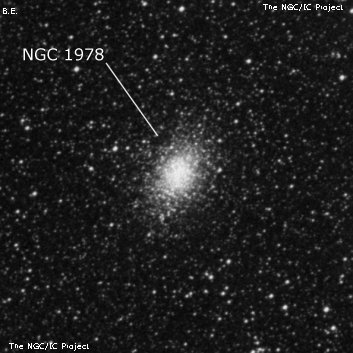
James Dunlop probably discovered NGC 1978 = D 238 = h2878 on 6 Nov 1826 and described "a faint round nebula, about 50" diameter. His position is 05 27 37, -66 21 (2000), about 10' SW of the globular.
JH first observed this bright globular on 2 Nov 1834, logging "vB, vL, E, gbM, 3'." On his final of 3 sweeps, he recorded "vB, vL; oval; vgpmbM; a beautiful nebula; it has very much resemblance to the Nubecula Major itself as seen with the naked eye, but is far brighter and more impressive in its general aspect as if the Nubecula were at least doubled in intensity. (Note - July 29, 1837. I well remember this observation, it was the result of repeated comparisons between the object seen in the telescope and the actual nubecula as seen high in the sky on the meridian, and no vague estimate carelessly set down. And who can say whether in this object, magnified and analysed by telescopes infinitely superior to what we now possess, there may not exist all the complexity of detail that the nubecula itself presents to our examination!)"
300/350mm - 13.1" (2/20/04 - Costa Rica): bright, large, elongated NNW-SSE, 2.4'x1.5' (unusually elongated for a globular), weak even concentration to center, no resolution. This is a blue intermediate-age cluster or "blue globular", roughly 2 billion years old, with a million solar masses. NGC 1948, a combination star cloud/emission complex, lies 18' W.
600/800mm - 30" (10/14/15 - OzSky): this impressive LMC (intermediate age) globular is extremely bright and large, noticeably elongated NNW-SSE, 2.3'x1.5', contains a large, very bright core (unresolved), and grainy halo. Only a few mag 15-16 stars were resolved around the edges at 303x. NGC 1978 is situated within the huge LMC-4 Superbubble that includes the NGC 1848 complex 18' WSW, NGC 2003 19' SE and the "Eighth-Note Nebula" (LHa 120-N55) 25' SE.
Notes by Steve Gottlieb